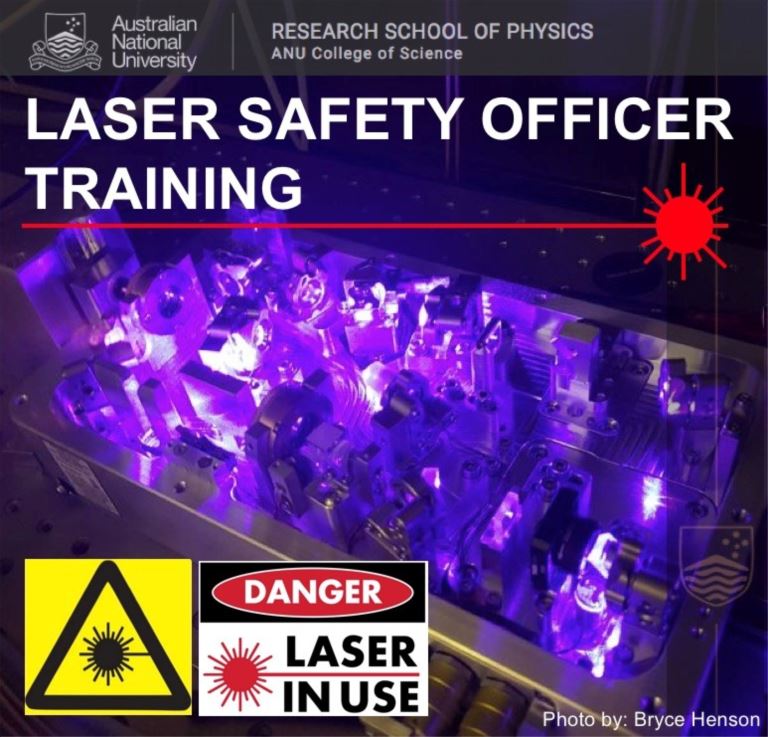Laser user (LU, 3 hours, Online or classroom)
Next session: 9:00 – 12:00, 16 July 2024
- Understand the basic principles of lasers
- Understand the basic interaction of lasers and biological tissue/eyes
- Laser safety standards
- Theoretical Examination
Intermediate Laser Safety Officer (I-LSO, 8 hours, Online and classroom)
Next session: 9:00 – 17:30, 16 July 2024
- LU coverage and
- Laser Safety Standards
- Qualitatively assess laser safety hazard risks and mitigation
- Classification of common lasers (Theory)
- Theoretical Examination
Advanced Laser Safety Officer (A-LSO, 50 Hours, Classroom and Laboratory)
Next session: 9:00 – 16:00, 16-19 July 2024
- LU AND I-LSO coverage and
- In-depth knowledge of laser principles and light-tissue interactions
- Actual experience of lasers of all classifications
- Quantitative assessment of laser safety hazard risks and mitigation (Theory and Experiment)
- Classification of all types of lasers (Theory and Experiment)
- Theoretical and practical examination
Courses
- Optics and Laser principles 1 (1 hr, Classroom or online); A-LSO, I-LSO and LU
- Laser Safety 1 (1 hr, Classroom or Online); A-LSO, I-LSO and LU
Level 3 Examination (1hour); LU only - Laser parameters and Laser Safety Standards (2 hrs, Classroom or Online); A-LSO and ILSO
- Assessment of laser hazards (1 hr Classroom, 1hr exam); A-LSO and I-LSO
Level 2 Examination (1hour) - Optics and Laser principles II (2 hrs, Classroom): A-LSO
- Laser Safety 2 (4 hours, Classroom/Tutorials; 3 hours practicals); A-LSO
- Laser Safety 3 (4 Hours, Classroom/Tutorials; 3 hours practicals); A-LSO
- Laser classification (5 hours, Classroom/Tutorials): A-LSO
Level 1 Final Examination (4 hours): A-LSO
Please download full information here
Upcoming 2024 Dates
- Date: 16 July 2024
- Time: 9am – 12pm
- Enrolment Fee: $450
- Location: Online Delivery

Course Schedule
- Lecture 1 (1 hr)
- Lecture 2 (1 hr)
- Laser user exam (1hr)
The Laser User Safety Training is a 3-hour introductory course on the safe use of lasers. This course can be taught via online or in-person learning and cater to students and researchers who intends to work with lasers. The course will provide basic understanding of laser principles and their interaction with biological tissue/eyes. The course will also orient the student on how to identify and mitigate risks and hazards on the use of lasers.
Learning outcomes
- Distinguish lasers from other light sources
- Identify the atomic or molecular processes involved in producing a laser beam
- Categorise the interactions between lasers and biological tissue/eyes
- Identify and mitigate risks and hazards on the use of lasers.
ANU staff qualify for a 50% fee reduction and staff/students from the Research School of Physics may qualify for a fee waiver. Please contact Dr Vincent Daria or Siobhan Ryman to check if you qualify for a fee reduction for this course.
Upcoming 2024 Dates
- Date: 16 July 2024
- Time: 12:30 – 17:30
- Enrolment Fee: $950
- Location: Online Delivery

Course Schedule
Session 1 – 9am – 12pm
- All Laser User Safety Lectures (Lectures 1-2)
Session 2 – 12.30 – 5.30pm
- Lecture 3 (2 hrs)
- Lecture 4 (1 hr)
- Intermediate LSO exam (1hr)
Course Description
The LSO-Intermediate training equips the student with the understanding to evaluate and mitigate laser hazards as well as the ability to assume responsibility to manage laser laboratories. This course will be taught via in-person or on-line learning and provides the student with the basic understanding of laser principles and their interaction with biological tissues i.e. skin and eyes. The course will orient the student on how to identify and mitigate risks and hazards on the use of lasers as well as prescribe suitable personal protective equipment. The course is ideally catered for researchers as well as laboratory managers of research laboratories where lasers are used.
Coverage
- Basic principles of lasers
- Laser Hazards – Understand the basic interaction of lasers and biological tissue/eyes
- Laser Safety Standards
- Laser safety hazard risks and mitigation
- Classification of different types of lasers
Learning outcomes
- Differentiate lasers from normal light sources
- Identify the atomic and molecular processes involved in producing a laser
- Categorise the interactions between lasers and biological tissue/eyes
- Identify and mitigate risks and hazards on the use of lasers.
- Articulate and explain the laser safety terminologies specified in the Aus/NZ Laser Safety Standards (AS/NZS IEC 60825.1:2014)
- Classify common lasers according to the AS/NZS IEC 60825.1:2014
- Identify engineering and administrative controls on the design of safe working environment for lasers
- Prescribe suitable personal protective equipment on the safe use of lasers.
ANU staff qualify for a 50% fee reduction and staff/students from the Research School of Physics may qualify for a fee waiver. Please contact Dr Vincent Daria or Siobhan Ryman to check if you qualify for a fee reduction for this course.